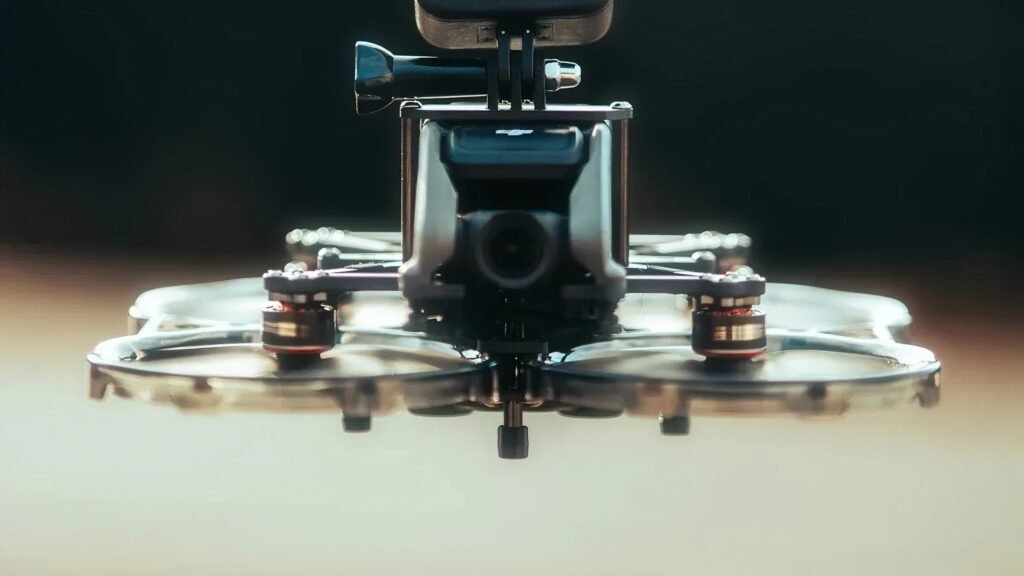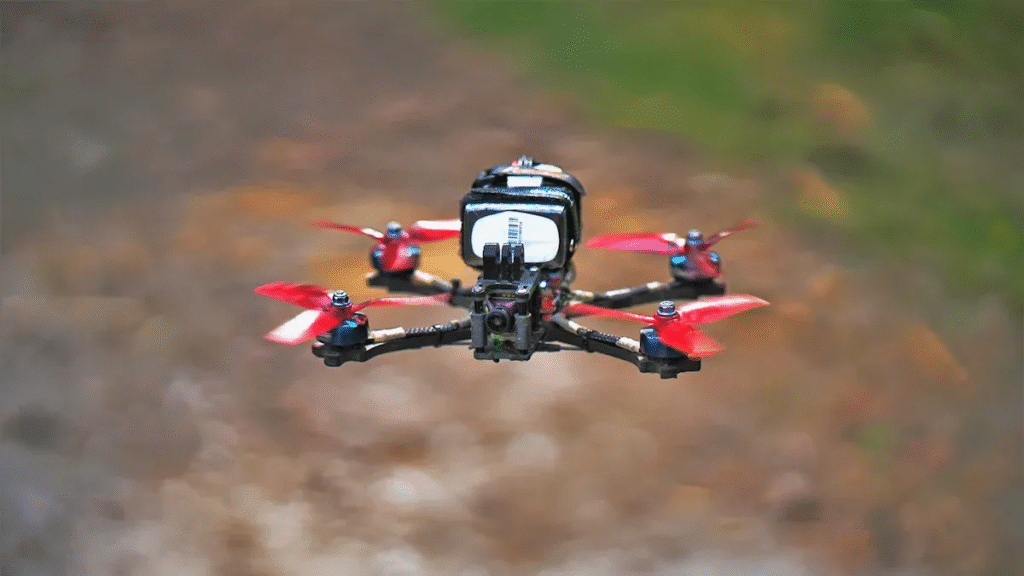A 1000kv motor typically delivers between 500 and 800 grams of thrust when you use a 3S battery and a 10-inch propeller. Your actual thrust depends on several factors, including propeller size and battery voltage. For example, tests with calibrated load cells show that larger propellers and higher battery voltages increase thrust output. You need to understand these relationships to build drones or RC planes that fly safely and efficiently. Always test your own setup to confirm the exact thrust you achieve.
Key Takeaways
- A 1000kv motor usually produces 500 to 800 grams of thrust with a 3S battery and 10-inch propeller, but thrust varies with propeller size and battery voltage.
- Thrust is the force that moves your drone or plane forward or upward, and enough thrust is needed to lift and control your drone safely.
- Larger propellers and higher battery voltages increase thrust but can cause motor overheating, so monitor temperatures and current draw carefully.
- You can measure thrust at home using a test stand and a digital scale to get accurate data and optimize your drone’s performance.
- Match your motor, propeller, and battery to your drone’s purpose and aim for the right thrust-to-weight ratio to ensure stable and efficient flight.
Thrust Basics
What Is Thrust?
Thrust is the force that pushes your drone or RC plane forward or upward. When you power up your motor, the propeller spins and moves air backward. This action creates a forward or upward force called thrust. You measure thrust in Newtons (N), which is the standard unit for force.
You can quantify thrust using several key parameters. Propeller pitch, diameter, and RPM all play a role. Manufacturers and hobbyists collect static thrust data by testing motors with different propellers at zero airspeed. They use standardized metrics such as propeller size (converted to meters), RPM, and power in Watts. Engineers often adjust theoretical equations with correction constants to match real-world results. These methods help you compare motors and setups accurately.
Note: In multirotor drones, you can estimate thrust by dividing the total weight by the number of propellers during a steady hover. This gives you a practical way to check if your setup can lift your drone safely.
Why Thrust Matters
Thrust determines if your drone can lift off, hover, and maneuver. If you want stable flight, you need enough thrust to overcome the weight of your drone and any payload. The amount of thrust also affects how quickly your drone can accelerate or change direction.
- Single rotor systems can produce between 1000 and 2000 grams-force. With four rotors, your drone can generate up to 8 kilograms-force, which defines its lifting capacity.
- Placing a payload above your drone causes little turbulence and keeps thrust loss minimal. You can carry larger payloads this way without losing stability.
- Placing a payload below your drone increases turbulence and vibration. This reduces thrust efficiency and makes your drone harder to control.
- Airflow tests and simulations show that payload position changes thrust distribution. You may need to adjust your setup to maintain stable flight.
Understanding thrust helps you choose the right motor, propeller, and battery. It ensures your drone flies safely and performs as you expect.
1000kv Motor Thrust
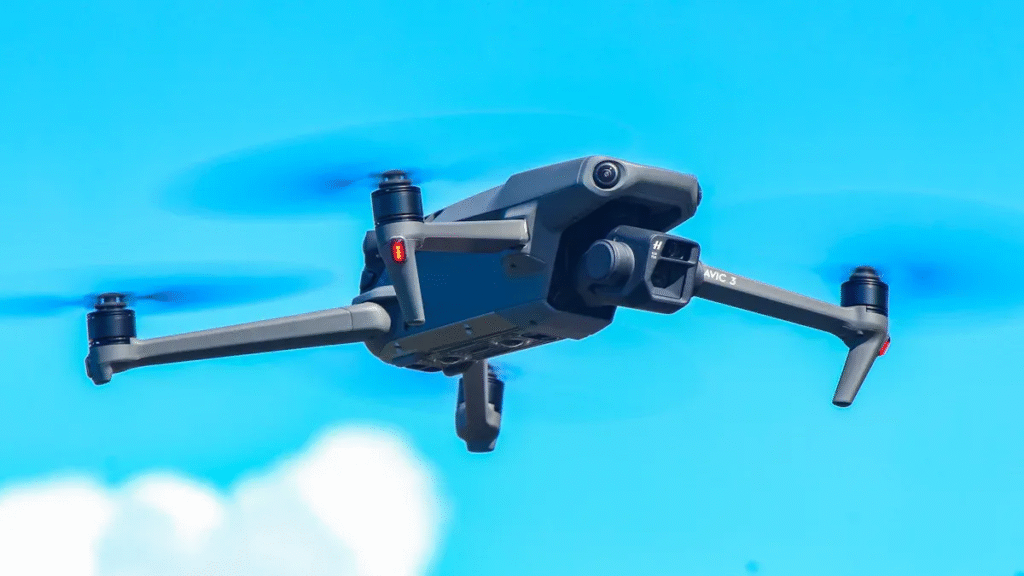
Typical Values
When you use a 1000kv motor, you can expect a wide range of thrust outputs depending on your setup. In real-world tests, a 1000kv motor paired with a 3S battery and a 10-inch propeller often produces between 500 and 800 grams of thrust. However, with different propeller sizes and higher battery voltages, you can achieve much higher thrust. For example, a Brotherhobby Tornado 3115 1050kv motor, which is close to a 1000kv motor, delivered around 2000 grams of thrust at 70% throttle using a 6S battery and a 9x5x3 tri-blade propeller. The table below summarizes these results:
| Parameter | Value | Notes |
|---|---|---|
| Motor | Brotherhobby Tornado 3115 1050kv | Example of a 1000kv motor |
| Battery | 6S (22.2V nominal) | Standard LiPo battery voltage |
| Propeller | 3-blade 9x5x3 | HQProp Macroquad Tri-Blade 9 inch |
| Throttle | 70% | Operating throttle setting |
| Current Draw | 22 A | Electrical current at 70% throttle |
| Voltage | 23 V | Measured voltage during test |
| RPM (calculated) | 23310 RPM | 22.2V x 1050kv = 23310 RPM |
| Thrust | ~2000 grams force (gf) | Thrust produced at 70% throttle |
| Input Power | ~540 W | Calculated from voltage and current |
| Thrust Efficiency | 3.68 | Thrust per watt (gf/W) |
| Notes | Motor overheated and motor mount melted | Indicates limits of this setup |
You should note that pushing a 1000kv motor to its limits can cause overheating. Always monitor motor and ESC temperatures during testing.
In community tests, users have reported that an 850kv motor with a 13×8 propeller can produce about 4 pounds of thrust while drawing 30 amps at full throttle. Larger propellers at lower RPMs often generate more thrust for less power than smaller props at higher RPMs. This means you can adjust your setup to get the best balance between thrust and efficiency.
Influencing Factors
Several factors affect the thrust you get from a 1000kv motor. You need to consider each one when building or tuning your drone:
- Propeller Size and Pitch: Larger propellers move more air and can increase thrust. However, they also draw more current and may cause your motor to overheat if you push them too hard. A higher pitch propeller can also boost thrust but may reduce efficiency.
- Battery Voltage: Higher voltage batteries, such as 4S or 6S, allow your 1000kv motor to spin faster. This increases RPM and thrust but also raises the risk of overheating and higher current draw. Always check your motor’s specifications before increasing voltage.
- Motor Efficiency: Not all 1000kv motors are created equal. Some have better cooling, higher quality magnets, or improved windings. These features help your motor deliver more thrust without overheating or wasting energy.
- Throttle Management: Running your motor at full throttle for long periods can cause excessive heat buildup. Using a watt meter and limiting throttle can help you avoid damaging your components.
Tip: Always test your setup with a watt meter and monitor temperatures. This helps you find the best combination of propeller, battery, and throttle for your 1000kv motor.
Thrust-to-Weight Ratios for Different Drone Types
The thrust-to-weight ratio (TWR) is a key metric for drone performance. It tells you how much thrust your motors produce compared to the total weight of your drone. Different drone applications require different TWRs:
| Drone Application | Example Weight (g) | Motor & Setup | Thrust per Motor (g) | Total TWR (ratio) | Recommended TWR Range | Notes on Flight Characteristics |
|---|---|---|---|---|---|---|
| Aerial Photography | ~1000 | 2207 motors, 6S, 5″ prop | ~500 | ~2:1 | ~2:1 | Stable flight, good for payload and efficiency |
| Freestyle / Moderate Racing | ~1000 | 2207 motors, 6S, 5″ prop | ~1600 | ~6.4:1 | 5:1 to 10:1 | Strong acceleration, good maneuverability |
| Racing Drones | N/A | High-performance motors | N/A | 10:1 to 14:1 | Above 10:1 | Extreme responsiveness, faster battery depletion |
For aerial photography, you want a TWR around 2:1. This gives you stable flight and enough power to carry a camera or other payload. If you fly freestyle or moderate racing drones, aim for a TWR between 5:1 and 10:1. Racing drones need even higher ratios, often above 10:1, for rapid acceleration and sharp maneuvers.
You should match your 1000kv motor, propeller, and battery to your drone’s purpose. For a photography drone, focus on efficiency and stability. For racing, prioritize high thrust and quick response. Always balance thrust, efficiency, and component safety for the best results.
Measuring Thrust
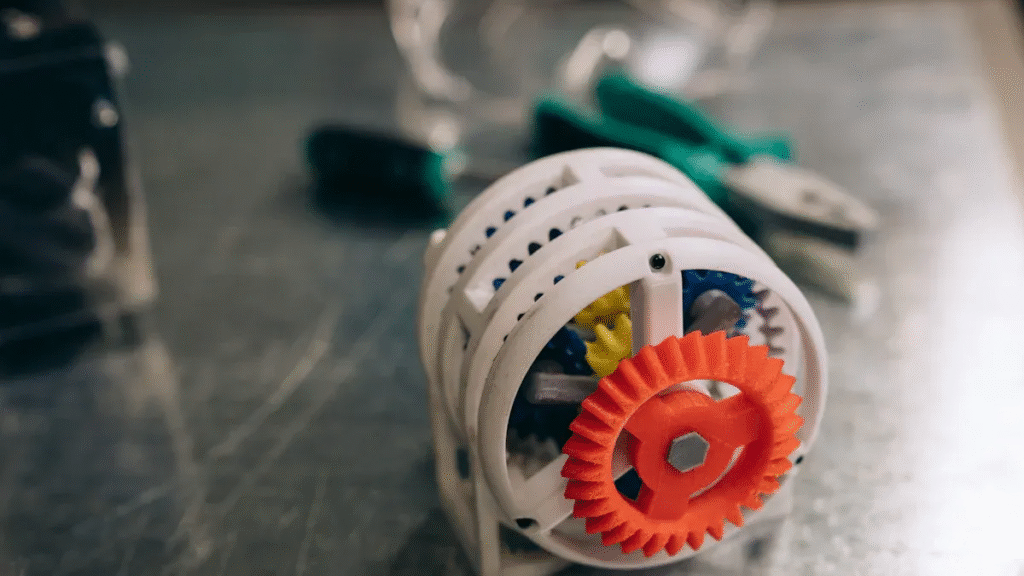
Estimation Methods
You can estimate thrust without expensive lab equipment. Start by using manufacturer data sheets. These often list thrust values for specific motor, propeller, and battery combinations. You can also use online thrust calculators. Enter your motor’s KV rating, propeller size, and battery voltage. The calculator will give you an estimated thrust value.
Some hobbyists use a simple formula:
Thrust (grams) ≈ (Current (A) × Voltage (V) × Motor Efficiency) / (Propeller Constant)
This formula gives you a rough idea, but real-world results may vary. Always remember that environmental factors, such as air density and temperature, can affect thrust.
Tip: Use estimation methods as a starting point. Always verify with real testing for the most accurate results.
DIY Testing
You can measure thrust at home with basic tools and careful setup. Many hobbyists build custom test stands to hold the motor and propeller securely. Attach a digital scale or load cell to the stand. When you power up the motor, the scale measures the force produced.
Here is how experienced hobbyists approach DIY thrust testing:
- Build a sturdy test stand using materials like aluminum or wood.
- Mount the motor and propeller securely to prevent movement.
- Connect a digital scale or load cell to measure thrust directly.
- Use data acquisition tools, such as TC Logger hardware and software, to record thrust and pressure.
- Run multiple tests—at least three, but five or six gives better data.
- Process the data using software like TCLogger2Excel to calculate averages and performance metrics.
- Pay attention to setup details, such as sensor placement and sealing, for reliable results.
- Reference established rocketry literature and analysis tools, such as BurnSim, for deeper insights.
You can achieve accurate, repeatable thrust measurements by following these steps. This approach helps you verify your estimates and optimize your drone or RC plane for the best performance.
Maximizing Thrust
Propeller and Battery Choices
You can maximize thrust from your 1000kv motor by carefully selecting your propeller and battery. A 1000kv motor works best with larger propellers because it spins at lower RPMs and delivers high efficiency. When you use a larger propeller, your motor can move more air, which increases thrust. However, you must ensure your motor provides enough torque to spin the propeller without overheating.
- Larger propellers (such as 10-inch or 11-inch) pair well with 1000kv motors for steady, efficient flight.
- High-pitch propellers can boost thrust but may require even more torque.
- Avoid using large propellers with high KV motors. This combination draws too much current and can damage your motor.
- Choose a battery that matches your setup. A 3S or 4S LiPo battery often works well with 1000kv motors and large props. Higher voltage batteries increase RPM and thrust but also raise the risk of overheating.
Tip: Always check your motor’s temperature during test flights. If your motor gets too hot, try a smaller propeller or lower voltage battery.
Setup Tips
You can optimize your drone’s performance by following a few key setup tips. Start by matching your thrust output to your drone’s weight. For steady flight, aim for a thrust-to-weight ratio between 3:1 and 4:1. If you want more aggressive performance, such as for racing, target a ratio closer to 5:1.
- Balance your propellers before each flight to reduce vibration and improve efficiency.
- Use a watt meter to monitor current draw and prevent overloading your motor or ESC.
- Secure all wiring and components to avoid power loss or interference during flight.
- Test your setup on the ground before flying. Measure thrust with a scale to confirm you meet your target ratio.
- Adjust propeller size or battery voltage if you notice excessive heat or low efficiency.
| Drone Type | Thrust per Motor | Total Weight | Recommended TWR |
|---|---|---|---|
| Photography Drone | 500g | 1kg | 3:1 – 4:1 |
| Racing Drone | 750g+ | 1kg | 5:1+ |
By carefully choosing your propeller, battery, and setup, you ensure your 1000kv motor delivers reliable thrust and keeps your drone flying safely and efficiently.
You can expect a 1000kv motor to deliver between 500 and 800 grams of thrust, depending on your setup. The right combination of motor, propeller, and battery makes a significant difference in performance. The table below highlights how different configurations impact efficiency and payload capacity:
| Component | Configuration | Efficiency / Performance Metric | Value |
|---|---|---|---|
| Battery | B1 (3300 mAh) | Payload capacity increase | 2.02 N |
| Battery | B2 (6000 mAh) | Payload capacity increase | 5.82 N |
| Battery | B1 | Propeller efficiency (12-inch propeller) | 12.9 % |
| Battery | B2 | Propeller efficiency (12-inch propeller) | 11.4 % |
| Motor | M1 (700 KV) + B1 | Motor efficiency | 64.29 % |
| Motor | M1 (700 KV) + B2 | Motor efficiency | 62.01 % |
| Battery | B2 vs B1 | Endurance | Greater with B2 |
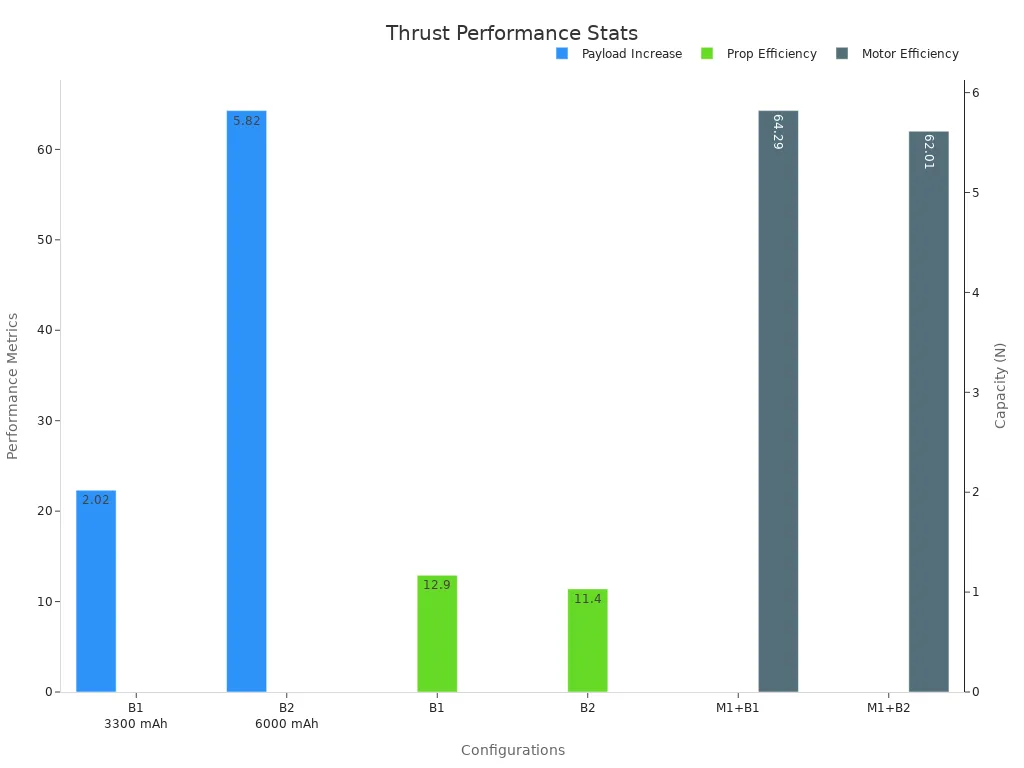
You should always test your own setup, monitor temperatures, and use these tips to optimize your drone’s thrust safely.

